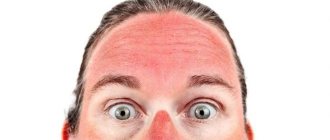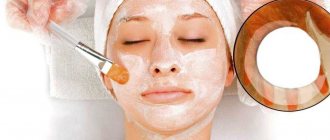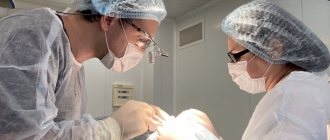Is it possible to completely remove a scar after a caesarean section?
Women should be immediately warned that it is impossible to completely get rid of any scar from a physiological point of view. However, modern means make the seam almost invisible. You shouldn’t succumb to advertising tricks that promise to remove the scar forever in a few days, and you shouldn’t thoughtlessly resort to “folk recipes.”
If you already have an unsightly scar after a cesarean section, then you should consult with a specialist or first study modern methods of scar correction. If you are just about to encounter this problem, then it is worth finding out how you can prevent the formation of a rough pathological scar.
IMPORTANT: The problem of getting rid of scars should not be put off for a long time. All non-surgical methods of scar correction are especially effective at the very beginning of scar formation. The older the scar, the more difficult it becomes to get rid of!
Why is it that sometimes almost invisible scars form after a cesarean section, and sometimes they are voluminous and ugly?
Scar formation is a natural tissue healing process during which connective tissue fibers form at the site of a surgical incision (or wound). Depending on how the healing process proceeds, the future appearance of the scar largely depends.
If the healing process proceeds without complications and the young mother does not have a genetic predisposition to the formation of excess scar tissue, then the result is the formation of a pale, almost invisible normotrophic scar. But in some cases, a pathological scarring process starts, the scar tissue grows, and an unsightly, voluminous pathological scar forms at the site of the wound. It is very important to properly care for the postoperative scar, then the healing stage will be shorter and the scar from the operation will be less noticeable.
The type of future scar also depends on the type of suture.
The essence of the procedure
The laser that will remove the scar consists of several beams that come at a short distance from each other. Some of them are deliberately directed at the scar itself. In it, they evaporate the columns of scar tissue, and the scar has to bring the edges between the micro-holes closer together. So it shrinks from the inside.
Some of the laser beams hit healthy skin around the scar. They cause a thermal reaction here, as a result of which the cells that are responsible for the formation of new skin elements are activated. They synthesize 3D scaffold structures, and they creep onto the scar, causing it to be replaced by normal covering tissue. This way the scar also shrinks on the outside.
- Find out the current offers
- Sign up for a consultation
Online registration
The procedure is sterile: in the area where the laser beams hit, the temperature becomes high - more than sufficient to destroy microbes. There are no burns: the cooling is turned on while the laser device is operating.
There will be no bleeding during the procedure: all blood vessels that fall within the laser’s area of effect are sealed. And if the beam hits the pigment spots, which also often surround the scar, then they also disappear.
What incisions are made during a caesarean section?
Such an operation has long ceased to be considered a dangerous surgical intervention on a woman’s body, because the technique of execution and the means used have already been sufficiently established. In short, the process consists of the following steps:
- the doctor first cuts the abdominal wall;
- then makes an incision in the uterus;
- removes the child;
- retrieves the placenta;
- puts a suture.
The delivery operation is performed under local or general anesthesia. The decision on the method of anesthesia is made by the anesthesiologist depending on the condition of the patient, the fetus and many other factors. But recently, doctors are increasingly using the first method. Your attending physician will provide details.
There are several options for making the cut. The surgeon can choose one of them. The speed of healing and tissue restoration depends on what he applies. This will also affect the appearance of the scar on the abdomen after a cesarean section.
Corporal section
In most cases, the scar after such an incision will be of impressive size - from the umbilical area to the pubic area. The healing process is quite long. In addition, scar tissue grows gradually and the injury site becomes denser.
Not everyone knows how to get rid of such a scar after a caesarean section, and it is not easy to do. The good news is that this incision is used only in emergency cases when fetal hypoxia or severe blood loss is present. When the question is about saving the life of a mother and child, the appearance of a scar is the last thing that worries the doctor and the patient. The main thing is to save lives.
Cross section
Widely used today. It leaves a small, neat scar from a caesarean section on the abdomen. But it's not just about aesthetics. Cross cuts allow you to:
- reduce the duration of the operation;
- reduce blood loss;
- speed up the healing process.
There are several types of transverse incisions, depending on the technique used:
- Pfannenstiel method - after surgery and in the absence of complications, the scar will be practically invisible. It looks like a thin thread of 10–12 cm. And over time, the scar may completely disappear. The operation is low-traumatic and the wounds heal quickly;
- Joel-Cochin method - an incision is made below the umbilical zone by 5-7 cm, after the intervention a scar of no more than 20 cm remains. During the operation, the doctor cuts the uterus in the upper part. The advantage of this technique is a less painful postoperative period. The fat layer mitigates trauma.
How does a suture on the uterus heal?
Don’t forget that after a cesarean section there are also stitches on the uterus. The incision is naturally closed with self-absorbing threads. The doctor monitors his condition, periodically performing ultrasound scans on the patient. As with the external suture, it is important to ensure that the internal one does not come apart and scars correctly.
There are no specific methods for treating and treating uterine scars. In order for the healing of the internal incision to proceed faster, in the postoperative period doctors may recommend douching with special solutions. And of course, intimate hygiene comes first - in order to prevent microflora disturbance, which in some cases leads to undesirable consequences during the healing of internal sutures. Uncharacteristic vaginal discharge should be a reason to consult a doctor.
A woman who has had a caesarean section is advised to plan her next pregnancy no sooner than 2 years later. This period is considered optimal for stabilizing the uterine scar.
There are no standards for the condition of the internal seam either. Usually the doctor evaluates its thickness and the dynamics of the tissue condition after surgery.
There is an opinion that the first cesarean is the right path to another cesarean in the second pregnancy. But this is not always true. In some cases, after surgery, a woman gives birth for the second time naturally.
The method of delivery largely depends on the condition of the scar zone and the course of pregnancy. But risks for pregnancy still exist: rupture of the “old” suture or the placenta accreting into it.
To reduce the risks during the healing of uterine scars and the next pregnancy, it is important to regularly visit a gynecologist.
- share with your friends!
When is a second caesarean section “threatened”?
Repeated caesarean section is recommended for girls who, for various reasons, cannot or do not want to give birth on their own. But even if a woman dreams of natural childbirth, she may well be prohibited from having it if there are the following indications:
- little or, on the contrary, a lot of time has passed since the birth of the first baby - if it is less than 2 years old, then the scar after a cesarean section is not yet strong enough, and if it is more than 8 years old, then it has already lost its elasticity;
- there were complications after the last operation - in case of a difficult rehabilitation period during the first cesarean, the procedure will be scheduled again the second time;
- incompetent scar - if it is thinner than 2.5 mm at the time of planning conception and less than 5 mm by the thirty-fifth week, then there is a high risk of rupture during natural childbirth;
- vertical suture - if the incision was longitudinal, then subsequent independent childbirth is excluded.
The healing process of any suture is individual, so it is impossible to predict with 100% probability what kind of scar will result. However, there are methods to prevent the formation of unsightly pathological scars.
When should you start preventing scar formation?
Prevention of the formation of a pathological scar can begin after complete epithelization of the wound (2-3 weeks after surgery). As already written above, if a woman removes a post-cesarean scar and makes it less noticeable, then its correction should begin as early as possible.
The speed and effectiveness of the scar correction process depends on the stage of formation. Scar formation is usually divided into 3 stages.
- The initial stage lasts 5-7 days after surgery and ends with the appearance of the primary scar. The seam is bright red or burgundy in color, with clearly defined edges. There is some pain, but this is natural during healing. Besides, they will pass soon.
- The second stage lasts about a month. During this period, the primary scar begins to thicken and changes its color to a less bright one. Pain and discomfort in the scar area stops. But itching may appear, which in some cases lasts up to a year. With a transverse cut, the seam softens within 12 months, and with a vertical cut, this process can last 2 years.
- The last stage lasts about twelve months and depends on the characteristics of each woman’s skin regeneration. During this period, the process of filling the wound incision with epithelium and connective tissue occurs, and a dense scar is formed. The number of vessels in the scar tissue decreases sharply, so the scar changes its color to pink or pale pink.
Once a scar has gone through the final stages of scarring, it becomes much more difficult to remove.
Find out which method of correcting scars and stretch marks is optimal for you!
doctor Svetlana Viktorovna Ogorodnikova.
doctor
What scars are called pathological?
After a cesarean section, a healthy normotrophic scar can form. This is a thin elastic scar located at the same level as healthy skin and almost similar in color to it. Over time, these scars themselves become thinner. They require virtually no correction, and if desired, they can be made even less noticeable with the help of peelings and proper care.
However, after surgery, pathological scars may form, most often these are hypertrophic and keloid scars, less often atrophic. In a nutshell, we’ll tell you how to distinguish one type of scar from another.
- Hypertrophic scars - clearly protrude above the skin within the suture, and may even decrease in size over time.
- Keloid scars are a very unpleasant type of scar; they also protrude above the skin, but gradually grow beyond the boundaries of the previous wound, penetrating into healthy tissue.
- Atrophic scars - consist of thinned tissue, located below the level of healthy skin, outwardly they seem to sink inward. When correcting this type of scar, an important step is to activate the skin’s production of healthy collagen, which will fill the sunken area.
Why do stretch marks and scars occur during pregnancy?
Stretch marks are a common occurrence in pregnant women. The reason for their appearance lies mainly in the large increase in extra pounds. Some pregnant women gain weight so quickly that the elasticity of the skin cannot cope, thereby forming stretch marks on the surface of the body.
After giving birth to a child, a woman may also encounter unpleasant scars. They occur with sudden weight loss. The skin sags, thereby leading to the appearance of scars on the body.
Scars after surgery (caesarean section) are also not fun. After all, scars do not decorate a woman. And the scar from the operation, although cosmetic, is still striking.
How to get rid of scars after cesarean section at home?
The choice of the optimal correction method depends on the type and age of the scar. Of course, the financial capabilities of a young mother also play a significant role. However, experts do not recommend resorting to the cheapest means, the effectiveness of which has not been proven. Such unprofessional or homemade “medicines” can provoke rapid growth of scar tissue, and there is also a high probability of losing valuable time and missing the period when the scar can be easily corrected.
If you have a young, loose scar, then conservative methods of treating scars in the form of skin applications of anti-scar gels or creams are suitable for you.
If you have an old, dense scar, then using only skin products will be ineffective and it is best to entrust the choice of correction method to a specialist. The presence of internal seals in the scar area, as well as painful sensations, may indicate the development of an adhesive process, in which case a trip to the doctor is vital.
Products for the correction and prevention of young scars.
- Silicone-containing gels and plates
- Anti-scar agents based on collagenase
- Products based on hyaluronidase
- Hormone-based products
- Products with plant extracts, vitamins, oils
Silicone-containing products are designed to moisturize and soften the skin in the scar area. Silicone-based gel is capable of prosthetizing the insufficient function of scarred skin, due to which the water balance in the epidermis is normalized and the scar is softened. Silicone-containing plates (bandages, patches) are designed in such a way that they are able to exert slight pressure on the scar, mechanically preventing the growth of the scar.
If you have already formed a protruding scar, then using only silicone-containing preparations will be ineffective (it is necessary to use products that can destroy scar tissue).
Now there are a large number of silicone-containing products from different manufacturers. Your choice should be based on the reputation of the manufacturer.
Collagenase is an enzyme that breaks down pathological scar tissue. Voluminous scars are formed when, during wound healing, pathological collagen appears instead of healthy collagen. Pathological collagen fibers are bonded to each other with hyaluronic acid. Collagenases are capable of destroying the very basis of the scar: pathological collagen and hyaluronic acid.
There are a number of collagenase-based products, but not all of them are equally effective because they contain enzymes of different activity. Experts highlight the product Fermenkol. The complex of collagenase enzymes included in its composition destroys pathological collagen and hyaluronic acid to individual amino acids.
Collagenase is used both to prevent scar formation and to correct existing scars. If you have a young scar, then skin applications with Fermencol gel will be sufficient. If the scar is older, then experts recommend using physiotherapy (phonophoresis, electrophoresis) together with Fermenkol. The procedures can be performed in a clinic or at home; all you need to do is purchase a phonophoresis kit.
Hyaluronidase is an enzyme that breaks down hyaluronic acid. As mentioned above, the basis of a pathological scar is pathological collagen, which is bound by hyaluronic acid. The destruction of hyaluronic acid leads to positive external changes in the scar (it decreases in volume), but if pathological collagen is not destroyed, then there is a high probability that the scar will later acquire its previous size and consistency.
Experts recommend using hyaluronidase-based products as a component in complex scar therapy. In this case, the set of measures should contain agents that can destroy pathological collagen.
Hormonal products contain synthetic or natural hormones (corticosteroids and glucocorticoids). They are prescribed exclusively by a specialist! To avoid adverse side effects, you must strictly follow your doctor's instructions and adhere to the dosage regimen. Self-use of products containing hormones is highly discouraged! In addition, it must be remembered that there are a number of contraindications. Pregnant and breastfeeding women should be especially careful when using hormonal medications; many of them are contraindicated for them.
Hormones prevent scar formation by reducing collagen production, and also inhibit areas of inflammation and fibroblast proliferation. Most often, hormonal agents are used in combination with other methods of scar removal.
Most often, products of this type contain fruit acids, which during use provide a light superficial chemical peel. When correcting a pathological scar, the result of such peeling will be almost invisible. But for caring for a neat normotrophic scar, a similar method can help make a neat scar even a little less noticeable.
Vitamins and all kinds of nutrients have a restorative effect on a fresh wound, promoting rapid healing and thereby preventing pathological scarring. Products with nutrients can be used to care for young scars for minor cuts, wounds and abrasions. They are also suitable for caring for a normotrophic scar after a caesarean section. But you shouldn’t count on any positive effect if your pathological scar has already begun to grow.
IMPORTANT: When using anti-scar agents, remember that the scar has natural stages of development: extensive growth, plateau, spontaneous regression of the scar. Sometimes the use of a remedy coincides with the natural stage of regression, which creates the illusion that the treatment is effective. Normotrophic, atrophic and hypertrophic scars can themselves decrease over time. Therefore, if you continue to use some product, but notice that the positive effect has stopped, this most likely means that the product itself was initially extremely ineffective.
Means for the correction of mature scars.
As noted above, using only skin products to get rid of mature scars will be ineffective and the choice of correction method is best left to a specialist. However, now there are special compact devices that allow you to carry out physiotherapy with anti-scarring agents at home.
- Physiotherapy with anti-scar agents based on collagenase. As mentioned above, collagenase-based products, such as Fermenkol, destroy the main components of scar tissue: collagen and hyaluronic acid. Physiotherapy (electrophoresis and phonophoresis) are an effective method of introducing collagenolytic enzymes into scar tissue. Thanks to their effect, active enzymes penetrate into deep areas of scar tissue, thereby accelerating the process of reducing pathological collagen. In addition, the procedures themselves also have a beneficial effect.
- Phonophoresis is an effective and painless procedure during which medicinal substances are introduced into the skin using ultrasound. Ultrasound increases the elasticity of connective tissue, stimulates metabolic processes, including intracellular metabolism, enhances the production of biologically active substances and increases the activity of enzyme systems.
- Drug electrophoresis is a common method of physiotherapeutic treatment. The therapeutic effect consists of a simultaneous positive effect on the body of electric current and active charged molecules of the medicinal substance. A drug depot (reserve) is created in the skin and subcutaneous fat, significantly increasing the exposure time of the drugs.
There are a number of compact devices that allow you to carry out phonophoresis and electrophoresis procedures at home. Their use can save patients time and money, and achieve better results in a shorter period of time. It is better to consult a specialist about what type of procedure should be carried out in each specific case. Physiotherapy also has its contraindications.
2). Electrophoresis with fermenkol
Electrophoresis with fermenkol is a physiotherapeutic therapy in which the introduction of a medicinal substance into the surface of the body is carried out under the influence of an electric current. It is believed that due to the action of electric current, the healing components penetrate better under the scar tissue. This therapy has a beneficial effect on the body. Under the layer of skin, fatty tissue accumulates the medicine, thereby increasing the duration of the drug.
Electrophoresis is done in courses. You will not see visible changes immediately, but after 5–10 sessions, your scar will be significantly reduced. With this therapy, side effects are extremely rare. After the procedure, the patient feels: slight tingling; slight itching; slight redness of the skin. All of the above symptoms are not side effects.
Electrophoresis is contraindicated in:
- pregnancy or lactation;
- women with heart and kidney failure;
- intolerance to current or drug components;
- in case of illness with high body temperature.
For scar removal, electrophoresis is an excellent solution. The procedure will destroy scar tissue and smooth out uneven skin. The appearance will only please you. In the shortest possible time, you will not only reduce the thickness of the scar, but you can also forget about it forever.
How to get rid of scars after cesarean section using medical methods?
- Plastic surgery
- Laser resurfacing
- Microdermabrasion
- Deep chemical peeling
When a scar has already formed and looks extremely unsightly, many doctors suggest getting rid of it by excision. Instead of a rough scar, the woman will receive a barely noticeable mark. This procedure is performed under local anesthesia and requires a period of rehabilitation. To resort to plastic surgery, you need to invest a lot of money and meet all medical indicators.
Another expensive procedure. To achieve the required effect for correcting a scar after a cesarean section, a whole course of treatment will be required, which may require from 5 to 10 procedures. Each procedure is quite painful and involves layer-by-layer removal of tissue. After each procedure, a recovery period is required.
This method of scar resurfacing is considered a more gentle method than laser resurfacing. Scar correction occurs by grinding with aluminum oxide microparticles. To achieve results, a course of procedures will be required (about 6-8 sessions). Each procedure lasts about half an hour. After the procedure, you should not sunbathe or apply unnatural cosmetics to the polished area of the body for 2–3 weeks.
The tripe is first treated with fruit acids, then cleansed with chemicals. This type of treatment is considered the most inexpensive and ineffective, so it is advisable to use it only for mild scars.











